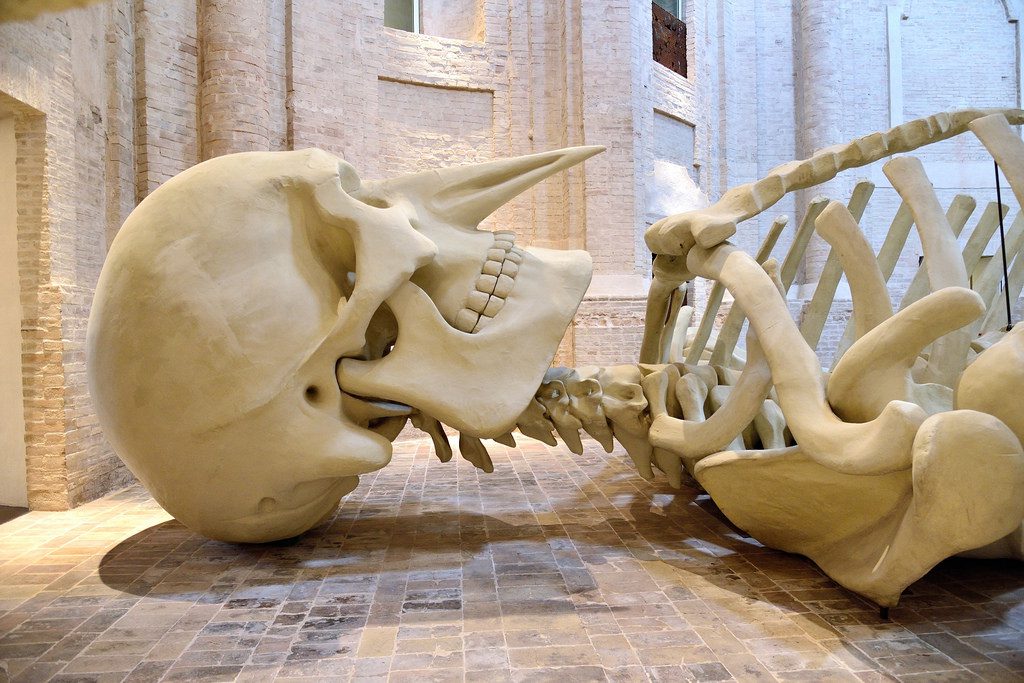The Cosmic Magnet is a monumental and controversial work by the Italian sculptor Gino De Dominicis, exhibited inside the former Church of the Santissima Trinità Annunziata in the historic center of Foligno.
After years of inactivity and abandonment, the Church was restored by the Umbria Region and the Cassa di Risparmio di Foligno to be used as a museum center. Completely emptied, the central nave of the building therefore lent itself to accommodate the 24 meters of the skeleton that forms the Cosmic Magnet in its entire length. The work, created secretly in 1988 and shown to the public for the first time in 1990 in Grenoble, found its definitive location only in 2011 in the aforementioned Church of Foligno, which curiously became an ideal setting. Before that, the Cosmic Magnet was moved and exhibited in various locations in Italy and Europe, from the Mole Vanvitelliana in Ancona to Piazza Duomo in Milan to the Palace of Versailles in Paris, arousing interest and debate.
So let’s try to understand more closely the characteristics of this unique work and the practical information useful for visiting it in person in Foligno.
In Foligno the Cosmic Magnet, a masterpiece by De Dominicis
Characteristics of the work Cosmic Magnet
The work “The Cosmic Magnet “, so called by the same author, represents a human skeleton of about 24 meters in length and 4 meters in width, lying on his back.
The skeleton shows a precise and exact anatomy, with the exception of the large bird’s beak nose placed on his face. This curious detail immediately catches the eye and makes the skeleton a sort of monumental monster. De Dominicis’ intent was in fact to provoke a sense of inferiority and smallness of the human, in the face of something clearly superhuman and therefore inaccessible.
The skeleton seems to hold a gold-colored iron rod, balanced on the tip of the middle finger of the right hand. The golden rod represents, in fact, that magnet that creates direct contact between the skeleton and the so-called cosmic world that surrounds it. The center of the whole work lies precisely in this link between man and the reality that surrounds him, with the rod creating a sort of magnetic field that incorporates the skeleton itself, which is both creator and user at the same time. .
Italo Tomassoni stated regarding the magnet:
“The genesis of Cosmic Magnet is unknown, which is the title attributed to the work by Gino De Dominicis on the occasion of the first public appearance of the work at the Museum of Contemporary Art in Grenoble. The work was created by the artist in absolute secrecy and unexpectedly exhibited at the Magazin of Grenoble in 1990. It will reappear six years later, alone, exhibited by Gino De Dominicis in the magnificence of the courtyard of the Capodimonte Palace in Naples as an example not only of his creative strength, but also of the other prerogative of his talent consisting in presenting a work as an absolute universe that exhausts in itself the reasons for its being “.
Gino De Dominicis, the artist of the Cosmic Magnet
Gino De Dominicis (Ancona 1947 – Rome 1998) was a rather controversial protagonist of post-World War II Italian art. Due to its differentiated and unique production, it is difficult to place it among the currents of the time and it cannot be defined as part of Arte Povera, Transavantgarde or Conceptual Art.
On the other hand, he always tried to make himself independent of fashions and avant-gardes both in his work and in his life: he distanced himself as much as possible from what he saw as a standardization of contemporary arts, reducing his own public appearances and publication of catalogs. For these attitudes, his figure is still surrounded by a certain aura of mystery: he distinguished himself for the isolation and confidentiality around his person.
Among the most recurring themes in his works, we often find alchemical and religious elements: crosses, stars, pyramids, geometric figures and above all figures with long noses. De Dominicis’ idea was that art was indeed creation and magic, not communication. In his vision, even the spectator was superfluous to the work, the value of which showed itself and exhausted itself.


Comment (0)